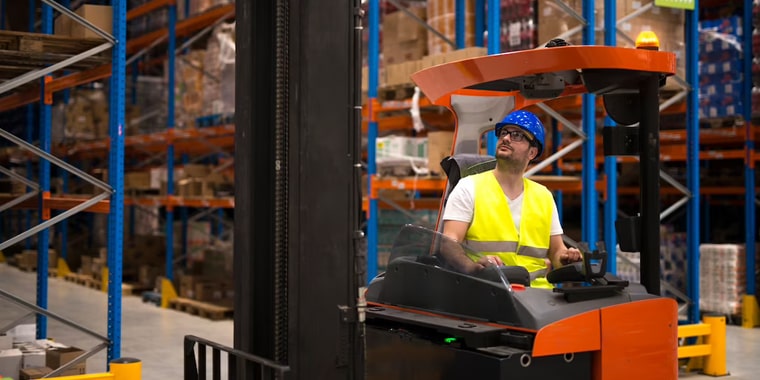
A Warehouse Management System is a software solution that helps to make the end-to-end supply chain operations more efficient.
It helps in tracking the exact location of each product from the time it enters the warehouse till it is packed and sent to its onward destination.
When the different partners in the supply chain are properly aligned, WMS can track inventory right from the manufacturer, through warehousing, up to the end-user also.
Businesses dealing with inventory on hand and eager to grow quickly should consider implementing warehouse management solutions as they can enjoy numerous benefits of WMS.
The system monitors processes at different levels, improves asset utilization, and boosts operational efficiency and productivity.
ALSO READ: Detailed Guide to Warehouse Automation
Let’s take a look at the key benefits provided.
One of the biggest advantages of warehouse management system is that it helps to optimize the workflow in the warehouse by studying the available floor space, tasks, and characteristics of the materials, and devises how best the space can be used.
It helps eliminate wasting precious floor space and reduces time required for locating products.
This translates into lower costs as there is less movement of material, and quick placement and retrieval of products.
It recommends the ideal locations for storage of products and equipment to lower cost.
They also facilitate rotation of materials, regardless of the rotation rule.
LIFO allows most economical space usage and movement.
FIFO and FEFO help maintain quality of products, preventing them from becoming obsolete.
A WMS is versatile and flexible, helping warehouse managers to make whatever adjustments are required for better employee productivity, right inventory picking, and physical movement management.
ALSO READ: Guide on ERP Software in Warehouse & Fixed Asset Management

You can get comprehensive visibility into real-time inventory levels and have an accurate number at any time, estimating supply correctly and eliminating backorders – leading to happy customers.
Modern techs like RFID, barcode scanning, QR codes, and other tracking methods afford visibility, leading to minimal lost or misplaced inventory in the warehouse.
A WMS works closely with ERP software to facilitate forecasting functions when they share information about product performance.
As products get sold, the indication for demand and seasonality are recorded.
Planners can combine the two to make informed decisions about the product mix that will help boost revenues and cut losses.
WMS software can help companies gain accurate insights about demand in the near future thanks to the increased visibility into its inventory.
The system considers historic trends and current inventory movements to predict future demand.
Accurate forecasts help warehouse operators to maintain optimal inventory levels. This is one of the most critical benefits of warehouse management.
ALSO READ: What is Demand Forecasting?

A WMS considers skills of warehouse employees, tasks, equipment, and so on to allocate tasks appropriately.
It can ensure optimized movement in the warehouse, reducing the time taken and increasing labor efficiency.
The tasks can be assigned every day so that employees can perform high-value activities.
With labor forecasting, the WMS assigns tasks every day, creating efficient schedules.
Items can be scanned as they enter the warehouse and move through it, avoiding the necessity of checking it again, and saving time, and making the process of recording fast.
With scanning, you can have accurate picking and deliver better customer service.
Important metrics that analyze staffing can help bring in more cost-effective and productive labor, and improve space and equipment efficiency by assigning work correctly.
ALSO READ: Why Should You Implement Trading ERP Software for Your Business?
A WMS is capable of prioritizing the important stuff for a specific project, like assigning the best people in the right location, setting the ideal warehouse routes, or targeting specific deadlines.
With labor forecasting, the right employees are allocated to the correct equipment at the ideal time, to enable the most efficient performance of tasks.
Floor simulators are included in modern systems, helping managers to efficiently plan warehouse layouts.
The ability of WMS to trace inventory materials is one of the important benefits of warehouse management system.
With the use of serial, batch, and lot numbers that indicate the specific item and the group in which they were made respectively, tracing them becomes easy.
You only have the ensure that the incoming goods and outgoing shipments match the specific serial or batch numbers, and you have complete traceability.
It allows for more precise inventory planning and distribution, minimizes redundancy, and offers updated information that can be retrieved for enabling tracing, product recalls, or service maintenance in the future.
ALSO READ: What Is Cloud Data Protection?

A WMS optimizes the internal operations of a warehouse, eventually extending the benefit to the wider supply chain.
In the warehouse, the system streamlines the whole process, from the time goods come in till they are shipped out, making operations more efficient and economical.
Unnecessary activities can be avoided and shipments can be made quickly and accurately.
Enhanced information and processes, cost and time savings can help all stakeholders improve their operations.
When inbound receipts process is improved, delivery times are shorter; it helps delivery partners to use their equipment better, and manage their inventory levels more efficiently.
Accurate, real-time data helps mitigate risk and improve reliability – these benefits customers, suppliers, and shippers.
Customers can get product delivery faster, and upstream customers can plan better.
Inventory management and fulfilment can be aligned to facilitate optimized operations, reduced time and inventory carrying costs.
ALSO READ: Debit Note vs Credit Note
Thanks to warehouse management software, other automation technologies can be easily integrated in warehouses.
With smartphones, the internal assignment of tasks and transition to electronic work from paper can be easily achieved.
Simplified processes deliver accurate information and allow scaling of work.
By integrating mobile, the WMS can help expand input process, as handheld mobile devices (like scanners) can gain access to it.
With automation, you can enhance strategies, and continuously improve your current operations.
Automated picking and packing, AI, robotics, etc. are just some examples.
As a WMS has the features that enable the capturing, communicating, and recording of activities, it supports these strategies.
When integrated with a WMS, barcodes, automated carousels, sensors, etc. can monitor picking and packing, and increase productivity.
Operations can be streamlined and constrictions can be further eased by using automated conveyors and robots.
It also facilitates digital transformation, enabling integration with ERP and other business software.
ALSO READ: Important ERP Modules and Features
Employees have to use unique user IDs to enter transactions in a WMS, creating an automatic audit trail linking particular employees with specific transactions.
This makes them accountable and lowers the risk of theft and fraud, and allows companies to discover strategies to improve staff behavior like new skills training programs.
As access levels are role-based and user-specific, it prevents unauthorized access to critical data, barring employees from viewing data not required for their tasks.
Your company data is automatically protected from prying eyes.
A warehouse solution can help you plan both inbound and outbound effectively, by adjusting inventory and equipment movement.
You can optimize the data and time of inventory receipt after factoring in available labor and equipment for storage tasks.
You can plan inbound and outbound docks with EMS, integrate with transport management and optimize the supply chain further.
WMS can also help in more efficient picking and packing, as it allows managers to choose the method of picking (wave, batch, zone, etc.) that reduces delays or problems due to poor employee locations or traffic.
These options quicken the order cycle time, improving customer service and building trust and loyalty.
The availability of inventory tracking options allows customers to know exactly where their shipments are at a specific time, and in what manner.
Warehouse management software facilitates a more straightforward relationship between customers and the company with such notifications.
ALSO READ: What is Customer Lead Time and How Can you Reduce it?

Implementing a WMS in your company helps in automating cumbersome manual warehouse tasks, boosting the morale of your employees.
When freed from routine tasks, employees can make more efficient use of their time and be more productive.
Employees will know what they have to do and for how long.
With smoother operations, employees are happier at work; when you manage their time better, they don’t have to work extra or overtime, and feel fatigued.
This means they are less stressed, and happier.
A happy employee is a productive employee.
It also helps reduce attrition in the long run.
With increased productivity, you can enjoy improved profitability.
ALSO READ: Benefits of Having an Employee Self Service System
A work environment that is relaxed and orderly makes it pleasant for the employees, eliminating or reducing strife between workers and management.
We don’t claim that a warehouse management solution will resolve every problem with your employees, but it will certainly help in defusing tensions between them and the management.
With a relaxed work environment, they will not have to rush through jobs, enhancing their safety.
All of these factors lead to happy and satisfied workers, further improving your business revenues.
Warehouse management solutions are important tech tools that facilitate improvements continuously.
The solution can be deployed in stages, allowing continuous updates with features developed newly in a consistent manner.
They help keep warehouses efficient as they strive to stay abreast of the changing environment.
In fact, it enables warehouses to integrate new processes and innovations as time goes by.
Cloud-based WMS is instantly updated, eliminating the requirement for full-fledged in-house IT professionals – again reducing expenses.
ALSO READ: What is Inventory Cycle Counting and What are its Benefits?
Undoubtedly, a WMS solution can help businesses reduce errors, speed up operations, boost productivity, and increase revenues.
However, a new system is usually met with some level of hostility by the end-users, lower-level employees, or even higher management.
Tranquil is experienced in helping companies transition to newer, more effective, cloud-based software to streamline business operations.
We have helped countless businesses undergo radical digital metamorphosis thanks to our expertise and our dedicated team.
Do you want to have an edge over your competition? Check out how Tranquil can help you do just that with a FREE demo! We are happy to answer any query you may have.